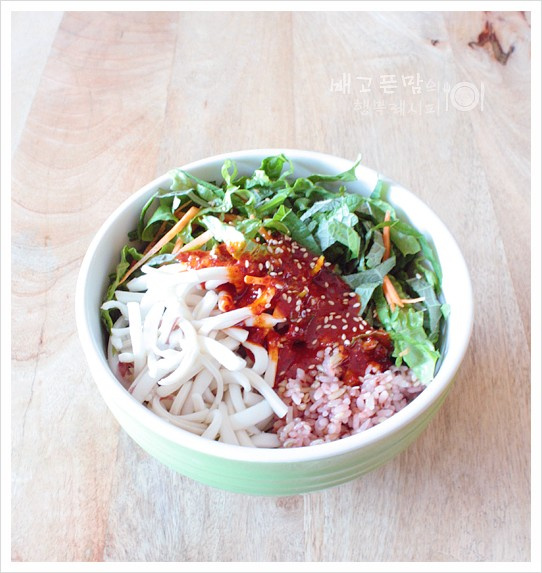Boiled Squid Bibimbap
Light & Healthy Diet Bibimbap: Boiled Squid Bibimbap Recipe

This is a diet bibimbap made using squid that was already peeled and prepared in the freezer. Enjoy a satisfying yet light meal by adding plenty of crisp lettuce from your garden and fresh vegetables, along with two spoonfuls of multigrain rice and tender boiled squid. The appetizing gochujang-based sauce is a special treat.
Bibimbap Ingredients- 5 large lettuce leaves
- 5 perilla leaves
- 1 Korean chili pepper
- 1/8 carrot
- 100g squid mantle (peeled and prepared)
- 2 Tbsp cooked multigrain rice
Cooking Instructions
Step 1
Prepare the fresh vegetables. You’ll need 5 crisp lettuce leaves, 5 perilla leaves, 1 Korean chili pepper, and 1/8 carrot. Wash them thoroughly. (Using larger lettuce leaves will provide a better texture.)

Step 2
It’s important to prepare the lettuce and perilla leaves to a good size for eating. First, cut each leaf in half lengthwise. This prevents the julienned vegetables from being too long, making them easier to mix into the bibimbap.

Step 3
Julienne the carrot thinly and finely. Slice the Korean chili pepper diagonally into thin pieces to add a pleasant spiciness. Arrange all the prepared vegetables attractively in your bibimbap bowl. The colorful presentation will whet your appetite.

Step 4
You don’t strictly need to peel the squid, but I used 100g of squid mantle that was already peeled and prepared from my freezer. First, cut off the triangular fins from the squid mantle, then cut the mantle lengthwise in half. If the pieces are thick, you can make a shallow cut to help them cook evenly.

Step 5
Julienne the prepared squid as thinly and finely as possible. This way, it will be tender when boiled and blend well into the bibimbap. If you prefer a chewier texture, you can cut them slightly thicker.

Step 6
Bring a pot of water to a rolling boil over high heat. Once the water is vigorously boiling, add the julienned squid. Adding it to hot water helps the squid cook to a firm, yet tender, texture.

Step 7
After adding the squid, stir it gently with chopsticks or tongs to prevent it from clumping together and to ensure even cooking. Avoid overcooking, as it can become tough. Aim for a quick blanching.

Step 8
The squid is cooked when it turns opaque and the water returns to a vigorous boil. (This usually takes about 1-2 minutes). Removing it at this stage will ensure a tender texture.

Step 9
Drain the well-boiled squid using a colander. Rinse it thoroughly under cold running water until it’s cooled down, and drain as much water as possible. Gently rubbing the squid while rinsing can help remove any excess sliminess. Squeeze out as much water as you can.

Step 10
Now, let’s make the delicious bibimbap sauce! While you can mix it directly in the bowl, preparing it beforehand is convenient. Start with 3 Tbsp of gochujang (Korean chili paste with vinegar). Add 1 Tbsp of vinegar for tanginess, 1/2 Tbsp of plum extract for sweetness, 1/2 Tbsp of gochugaru for extra spice, 1/3 Tbsp of minced garlic for flavor, and finally, 1 Tbsp of sesame oil for nuttiness. Stir all the ingredients well until they are fully combined.

Step 11
Arrange the beautifully prepared vegetables in your bibimbap bowl. Add the tender boiled squid neatly on top, and place 2 Tbsp of warm multigrain rice in the center. You can adjust the amount of rice to your preference. If you’re on a diet, feel free to reduce or omit the rice.

Step 12
Finally, add your desired amount of the delicious sauce you prepared. Adjust the quantity to your taste. Using chopsticks or a spoon, mix everything together thoroughly – the vegetables, rice, and sauce – until well combined. Enjoy! The combination of crisp vegetables and tender squid is simply delightful!


